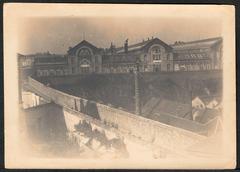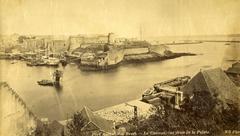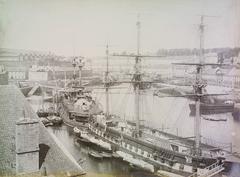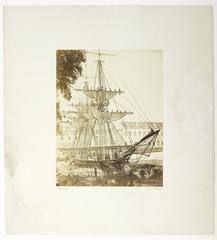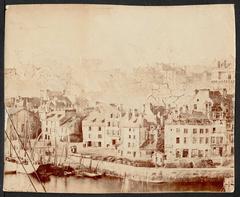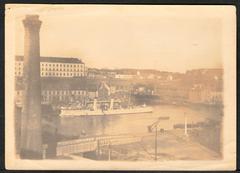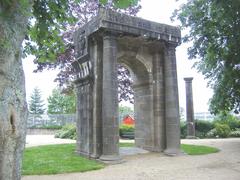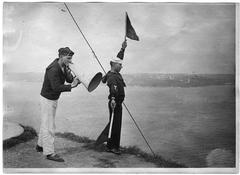Monument Aux Administrateurs Du Finistère: Visiting Hours, Tickets, and Guide to Brest Historical Sites
Date: 14/06/2025
Introduction
Located in Brest, within the Finistère department of Brittany, France, the Monument Aux Administrateurs Du Finistère stands as a solemn tribute to twenty-six local administrators executed during the Reign of Terror in 1794. Erected in 1865 in the Cimetière Saint-Martin, this neoclassical granite memorial commemorates not only a tragic revolutionary episode but also the enduring spirit of civic duty and resilience that defines Brest. Its blend of historical depth, architectural dignity, and accessibility makes it an essential site for understanding both the city’s past and its contemporary identity (archives.finistere.fr; Brest Métropole Tourisme; Wikipedia: Brest, France).
This guide provides detailed historical context, practical visiting information—such as hours, accessibility, and guided tours—and recommendations for nearby attractions, ensuring a comprehensive and enriching experience for visitors.
Table of Contents
- Introduction
- Historical Context: The Administrators of Finistère
- Tragedy and Remembrance: Arrest, Trial, and Execution
- Creation and Symbolism of the Monument
- Architectural Overview
- Visiting Information
- Accessibility and Facilities
- Guided Tours and Annual Events
- Nearby Attractions and Travel Tips
- Photography and Best Visiting Times
- Annual and Civic Events
- Frequently Asked Questions (FAQ)
- Conclusion and Practical Summary
- References
Historical Context: The Administrators of Finistère
Role and Federalist Insurrection
Following the creation of the Finistère department in 1790, thirty administrators were elected to implement republican reforms, including the reorganization of districts, local governance, and defense of the Republic. In 1793, tensions between moderate federalists and radical revolutionaries culminated in an attempted insurrection by these administrators, who opposed the expulsion of the Girondins from the National Convention and sought to restore moderation by mobilizing local forces (archives.finistere.fr; fr.wikipedia.org).
Arrest, Trial, and Execution
After the failed federalist uprising, the administrators were arrested, tried, and twenty-six were sentenced to death by the Brest Revolutionary Tribunal on 22 May 1794. Their execution by guillotine at Place du Château became a symbol of the era’s political extremism and the dangers faced by those advocating for moderation (archives.finistere.fr).
Creation and Symbolism of the Monument
Erection and Purpose
The monument was erected in 1865, initiated by the descendants of the executed administrators and local civic leaders, at the Cimetière Saint-Martin. Crafted from Aber-Ildut granite and adorned with neoclassical and Breton motifs, it blends architectural dignity with regional identity. The remains of the administrators, discovered in 1859, were reinterred at the site, further enhancing its solemnity (journals.openedition.org; fr.wikipedia.org).
Symbolic Elements
The monument incorporates classical forms—such as a central pedestal with inscriptions and allegorical reliefs—and Breton symbols like the ermine and triskelion, underscoring both national and local significance (Monumentum: Finistère).
Architectural Overview
- Materials: Constructed from durable local granite, resistant to Brest’s coastal climate.
- Design: Neoclassical style with balanced proportions, bronze bas-reliefs, and regional motifs.
- Inscriptions: Names of the twenty-six administrators and dedications in French (sometimes Breton), reflecting the area’s bilingual heritage (Brest Métropole Tourisme).
Visiting Information
Location
- Address: Cimetière Saint-Martin, central Brest.
- How to get there: Easily accessible on foot from the city center, or via local buses and trams. Parking is available nearby for visitors arriving by car (Mapcarta).
Visiting Hours and Admission
- Open: Year-round, typically from 8:00 AM to 6:00 PM (seasonal variations possible). The monument itself, being outdoors, can be viewed during daylight hours.
- Admission: Free; no ticket required (Brest Métropole Tourisme).
Accessibility and Facilities
- Physical Access: The cemetery features paved paths suitable for wheelchairs, though some areas may have uneven ground.
- Restrooms, Cafés, Shops: Located nearby in the city center.
- Information Panels: Historical context is provided at the site, though primarily in French.
Guided Tours and Annual Events
- Guided Tours: While there are no tours dedicated solely to the monument, it is frequently included in broader historical walking tours of Brest, available in French and sometimes English (Brest Métropole Tourisme).
- Annual Events: The monument is a site for civic ceremonies on national remembrance days such as Armistice Day and Bastille Day, as well as during European Heritage Days in September, which feature special tours and commemorations (Agenda Culturel; Brest.fr Agenda).
Nearby Attractions and Travel Tips
- Château de Brest: Medieval fortress and National Maritime Museum (France Voyage).
- Tour Tanguy: Historic tower with city history exhibits.
- Musée des Beaux-Arts: Regional and international art collections.
- Jardin des Explorateurs: Green space ideal for relaxation.
- Océanopolis: Major aquarium attraction (Generation Voyage).
Travel Tips: Wear comfortable shoes, bring rain gear, and explore local cafés for authentic Breton cuisine.
Photography and Best Visiting Times
- Photography: Permitted; best lighting in early morning or late afternoon. Drones require prior authorization.
- Best Times: Late spring to early autumn (May-September) for mild weather and cultural events.
Annual and Civic Events
The monument plays a role in local ceremonies on national holidays and remembrance days, as well as in educational programs and art projects. Its presence is felt during city festivals and as part of Brest’s cultural walks (Brest Metropole Tourisme).
Frequently Asked Questions (FAQ)
Q: Are there entrance fees or tickets required?
A: No, visiting the monument is free of charge.
Q: What are the visiting hours?
A: The site is generally accessible from 8:00 AM to 6:00 PM, but the outdoor monument can be viewed at any daylight hour.
Q: Is the monument wheelchair accessible?
A: Yes, via paved pathways, though some surfaces may be slightly uneven.
Q: Are guided tours available?
A: Yes, as part of broader city tours; check with the Brest Tourist Office for schedules and languages.
Q: What other historical sites are nearby?
A: Château de Brest, Tour Tanguy, Musée des Beaux-Arts, and the Jardin des Explorateurs.
Q: When is the best time to visit?
A: May to September, especially during European Heritage Days or city festivals.
Conclusion and Practical Summary
The Monument Aux Administrateurs Du Finistère is a powerful symbol of Brest’s revolutionary history and civic values. Its central location, free access, and integration with Brest’s broader historical and cultural attractions make it an essential stop for visitors interested in French history, architecture, and Breton identity. Plan your visit to coincide with local events for a deeper cultural experience, and consider joining a guided tour for expert insights.
For the latest visiting details, guided tour information, and updates on events, refer to the official Brest tourism website. Download the Audiala app for audio guides and explore related articles for a richer understanding of Brest and Brittany.
References and Further Reading
- Jugement et condamnation des 30 administrateurs – Archives Finistère
- Exécution de vingt-six administrateurs du Finistère sous la Terreur – Wikipedia
- Brest Métropole Tourisme
- Wikipedia: Brest, France
- Monumentum: Finistère
- France-Voyage: Brest Historical Site Visitor Guide
- Brest.fr Agenda
- Mapcarta: Brest Monument Location
- OpenEdition Journals: Brest Revolutionary History
- France Voyage: Château de Brest and Brest Naval Museum
- Agenda Culturel: European Heritage Days
- Generation Voyage: Visiting Brest

